Tribunal decision on wpd expected in February
Administrator | Dec 18, 2015 | Comments 20
The evidence phase of the Environmental Review Tribunal on the White Pines wind project has concluded. It is expected to return to the County Jan. 20 and 21st for oral submissions.
The ERT will next hear submissions of the parties as follows:
Appellant Written Submissions – Jan. 5, 2016
Respondent Written Submissions – Jan. 15
Reply Written Submissions – Jan. 19
Oral Submissions – Jan. 20 in Prince Edward County
ERT co-chair Marcia Valiante noted this schedule leaves insufficient time for the tribunal to meet the regulatory six-month deadline. As a result, the tribunal found that stopping the clock on the proceedings is required. Following the oral submissions the ERT will adjourn for four weeks and issue a decision on Feb. 19, 2016.
By Paula Peel, APPEC
DEC. 15 – On Day 21 the Environmental Review Tribunal (ERT) heard the last witness in the appeal of the White Pines wind project.
APPEC tried to call three Reply Witnesses: Dr. Shawn Smallwood, an expert in avian wildlife behaviour and conservation; Robert McEwen, P. Eng., a structural engineer; and Kari Gunson, a road ecologist.
Mr. McEwen and Ms. Gunson were intended to respond to wpd’s witness Shawn Taylor, who had done a survey of municipal roads on the day before he testified. Eric Gillespie, counsel for APPEC, asked the tribunal either to disallow the new evidence collected at the 11th hour or to allow APPEC an opportunity to respond. Mr. Gillespie argued that each party should have an equal opportunity to reply to the full submission of the other.
Both MOECC counsel Andrew Weretelnyck and wpd counsel Patrick Duffy objected to the admissibility of Mr. McEwen and Mrs. Gunson as Reply Witnesses. The tribunal agreed with their submissions and found that of the three witnesses only Dr. Smallwood’s evidence was proper reply.
Dr. Smallwood told the ERT he disagreed with wpd witness Dr. Strickland that pre-construction bat surveys have no value. He directed the tribunal to graphs showing a plausible correlation between pre-construction bat activity and post-construction bat mortality. He noted that when more data is added the more the relationship is strengthened. This suggests there is value in doing pre-construction surveys to estimate bat fatality rates.
Dr. Smallwood also noted that avoidance is not the same as displacement. While avoidance on a large scale will equal displacement, it might just as well involve manoeuvres to evade turbine blades, wind turbines, or an entire wind project. Repeated avoidance that leads to habitat loss is displacement.
Knowledge of threatened birds might have influenced opinion
By Henri Garand, APPEC
DEC 11 – On Day 20 the Environmental Review Tribunal (ERT) on the White Pines wind project heard APPEC witness Rick James and an expert witness for developer wpd, Dr. Dale Strickland.
Mr. James, qualified previously as an acoustician, presented new evidence in reply to Denton Miller, witness for the Ministry of Environment and Climate Change (MOECC). Following new ministry guidelines and omitting disallowed wind turbines T7 and T11, he calculated that 13 “points of receptions” (i.e., homes) would suffer noise above 40 dBA.
Both MOECC counsel Andrew Weretelnyck and wpd counsel James Wilson questioned Rick James on 40 dBA as a measure of serious harm. James said the MOECC had set this compliance limit and the World Health Organization (WHO) had found health effects, specifically annoyance and sleep disturbance, start at 40 dBA.
In re-examination, APPEC counsel Eric Gillespie confirmed with James that WHO had reported noise complaints during nighttime begin at 35 dBA.
Dale Strickland, Ph.D., founder and president of Western EcoSystems Technology, a Wyoming consulting firm with business and government clients, has published more than 150 scientific papers and technical reports during a 40-year career. The tribunal qualified him as “a zoologist with expertise in ecological research and wildlife management, including assessing the impacts of wind turbines on wildlife.”
WPD counsel Patrick Duffy asked Dr. Strickland about the appropriate scientific measure for serious and irreversible harm. He said it is based on the overall genetic and demographic status of a species’ population.
According to Dr. Strickland, the White Pines surveys of birds and bats are “adequate,” conform to established methods and published guidance, and are similar to those for other wind projects. Bats would not be high in number without the presence of hibernacula. Acoustical surveys are not necessary because they record bats at ground level and the results do not correlate with bat deaths at wind turbine rotor level.
Dr. Strickland also said the effects on habitat would be minimal. Loss from access roads and other construction is relatively small, and displacement from habitat would not be significant because of the project size.
Regarding collisions, Dr. Strickland predicted 5-15 bird deaths annually per turbine, the same as at other North American sites. He defended the Wolfe Island monitoring records, stating the mortality rates are reasonable for a searched radius of 50m, an area commonly used at other wind projects. Considering the project location and size, he concluded that White Pines would not cause serious and irreversible harm to wildlife.
In cross-examination Eric Gillespie confirmed that Dr. Strickland had not visited the White Pines site but had based his opinions on wpd’s reports and on Google Earth images. Although aware of Prince Edward Point National Wildlife Area and Point Petre Provincial Wildlife Area, he did not know their proximity to wind turbines. However, he dismissed the “globally significant” South Shore Important Bird Area because the IBA designation reflects convenient public access and use of the site for bird-watching.
Dr. Strickland did not know of an “activity report” by the Ministry of Natural Resources and Forests finding five threatened bird species and three bat species in the White Pines area. He agreed with Mr. Gillespie that such information might have influenced his opinions. Similarly, he conceded that if there had not been adequate surveys for karst, then one needed more information to estimate the bat population. He also admitted that the cumulative effects of wind projects must be considered to determine local impacts on birds.
When asked by ERT co-chair Marcia Valiante about a proposed 31ha compensation property, Dr. Strickland said it would have little measurable effect on the populations of displaced bobolinks and eastern meadowlarks.
Witness does not accept concept of wind turnbine syndrome
By Henri Garand, APPEC
DEC. 8 – On Day 19 the Environmental Review Tribunal (ERT) of the White Pines wind project heard the testimony of Dr. Robert McCunney, an expert witness for developer wpd.
Robert McCunney, MD, has a Boston clinical practice and is a research scientist at the Massachusetts Institute of Technology. Funded by the Canadian and American Wind Energy Associations, he headed teams in both 2009 and 2014 that produced status reports such as the recent “Wind Turbines and Health: A Critical Review of the Scientific Literature.” Though not licensed to practice medicine in Ontario, Dr. McCunney has testified on behalf of the wind industry at other ERT hearings.
The tribunal qualified Dr. McCunney as “a medical doctor specializing in occupational and environmental medicine, with the particular implications of noise exposure.”
wpd counsel James Wilson asked Dr. McCunney to comment on wind turbine sounds. He said that noise is characterized by loudness and pitch, low frequency is associated with vibrations, and infrasound is inaudible below 107 db(A). The last feature also occurs in the natural environment (e.g., wind and waves) and in actions of the human body such as breathing. Turbine infrasound cannot be distinguished beyond 300m.
Dr. McCunney’s 2014 literature review, based on 162 published papers, concluded that “(1) infrasound sound near wind turbines does not exceed audibility thresholds, (2) epidemiological studies have shown associations between living near wind turbines and annoyance, (3) infrasound and low-frequency sound do not present unique health risks, and (4) annoyance seems more strongly related to individual characteristics than noise from turbines.” Nothing Dr. McCunney has read since publication changes his opinions.
In cross-examination, APPEC counsel Eric Gillespie established that Dr. McCunney has never treated anyone complaining of turbine-related symptoms or conducted any original field research. Though he lives near a wind turbine, his home is 1500m away.
Mr. Gillespie asked Dr. McCunney to confirm the findings in several studies cited in his literature review that turbine sounds annoyed 7-18 per cent of nearby residents. But Dr. McCunney said this is similar to other environmental noise. Moreover, he does not accept the concept of “wind turbine syndrome,” in which a number of symptoms are associated with wind turbines and disappear in their absence.
Dr. McCunny was then asked to consider the 2015 Australian Senate inquiry, which received almost 500 worldwide submissions on wind turbine noise. He said he had not read it, but he was critical of its reliance on a range of unverified reports rather strictly published studies. He did accept, however, the finding that the “distinction between direct and indirect effects is not helpful.”
Finally, Mr. Gillespie asked at what distance from turbines complaints would cease. Dr. McCunney expressed confidence in Ontario’s 550m minimum setbacks.
In re-examination wpd’s Wilson asked about sleep anxiety and deprivation, which can lead to serious medical conditions. Dr. McCunney said no study shows a causal relation between these symptoms and wind turbines. His 2014 literature review identifies “longitudinal assessments of health pre- and post-installation” and “enhanced measurement techniques to evaluate annoyance”—but not sleep problems—among “further areas of inquiry.”
Witnesses dispute harm, impacts of turbines on environment
By Paula Peel, APPEC
DEC. 7 – On Day 18 of the Environmental Review Tribunal (ERT), APPEC expert witness Dr. Daryl Cowell testified there is substantial evidence of karst in the White Pines study area and that serious and irreversible impacts will occur if this project proceeds. wpd witness Ronald Donaldson and Ministry of the Environment and Climate Change (MOECC) witness Mark Phillips disputed this.
Dr. Cowell told the ERT he has appeared as a karst expert witness before eight Ontario Municipal Board hearings, done work for municipalities across Ontario, and authored or co-authored hundreds of technical documents, including peer-reviewed papers. He has spent 40 years studying karst, with the past 20 years focused on hazard assessment. Dr. Cowell was qualified as a professional geoscientist with expertise in karst.
Dr. Cowell said that a major karst area runs through Black Creek Valley ANSI (Area of Natural and Scientific Interest). Physical evidence of karst includes sinkholes and crevices (as identified earlier by area resident and presenter Doug Murphy), an artesian-like stream, year-round springs that go underground, dry wells, and extensive limestone pavements. Turbines would be located in epikarst, the upper boundary of a karst system, close to the edge of the valley. The access road to wind turbines T02 and T03 crosses Black Creek and proceeds through a zone of karst features including crevices one foot wide and 10 feet deep.
However, none of wpd’s Renewable Energy Approval reports identified karst features, assessed potential impacts, or even surveyed water bodies except in September and October, known to be low-flow periods.
Dr. Cowell noted that mapping the watershed in a karst aquifer is extremely difficult when vertical and horizontal fractures make water flow unpredictable and boundaries are always in flux. A storm water management plan is out of the question because it is impossible to determine the high water mark, a basic requirement for construction activities.
According to Dr. Cowell, blasting and trenching for 16 kilometres of new access roads, collector lines, and turbine bases will cause serious and irreversible harm to shallow karst areas. Blasting and backfilling through the upper metre of bedrock will dam and divert flows resulting in permanent impacts to the surface water/groundwater regime.
wpd witness Ronald Donaldson was qualified by the tribunal as a hydrologist. His testimony focused on potential interference with the quality and quantity of the local water supply aquifer and groundwater.
Donaldson reviewed aerial photographs, maps and literature that show no conclusive evidence of karst in Prince Edward County. He considers the Black Creek Valley a sub-glacial tunnel formed long ago by glacial melt-waters. Though predicting impacts such as sediment in shallow water wells and wetlands, he said there are mitigations for the temporary effects as well as for sinkholes or fractures opened during construction. Donaldson agreed with APPEC counsel Eric Gillespie, however, that alterations to the top three metres could impact wetlands.
Mr. Gillespie referred Donaldson to a 2013 study cited by Dr. Cowell, “Evaluating karst risk at wind power projects.” While agreeing that karst evaluations should be done early, Donaldson said he was not qualified to speak to the study’s number one mitigation—to move the turbines.
Mark Phillips, of the MOECC, was qualified as a surface water specialist with expertise in identifying risks to and mitigation of surface waters. Starting in October 2014, Phillips raised a number of issues about the lack of detail on project impacts on wetlands in wpd’s Construction Plan Report, the risk of impacts during construction on surface water, and the timing of surveys for water bodies. However, wpd chose to rely on existing MOECC records rather than carry out additional field work.
Phillips considers that risks from erosion and sediment can be fully managed by the “mitigation toolbox” and the effects will be temporary. He confirmed with Mr. Gillespie that he did not review the wetlands near turbines T27, T28, and T29 or, indeed, the Natural Heritage Assessment on wetlands.
wpd witness declares minimal harm; statements incorrect
By Henri Garand, APPEC
DEC. 4 – Day 17 the Environmental Review Tribunal (ERT) of the White Pines wind project heard testimony of wpd witnesses Shawn Taylor and Dr. Paul Kerlinger.
Mr. Taylor was qualified by the tribunal as “an ecological restoration and construction mitigation specialist.” However, he testified at length about Blanding’s turtles because of his participation in a four-year study involving a Kanata road extension into their habitat.
After classifying the roads (paved, gravel, and access) required for White Pines, Taylor spoke about the risks from higher traffic, but he said these are minimal due to the “block-out period” on construction between April 15 and October 15, and the later infrequent maintenance visits. He said mitigations such as staff training and 15km speed limits will protect turtles.
Taylor said “new roads would not increase fragmentation of Blanding’s turtle habitat.” He described the access roads as “laneways” flush to the ground surface and therefore not a barrier to turtles. Similarly, turtles will readily move through the nine culverts to be constructed. The roads would also not interfere with water flow into deep wetlands, crucial overwintering habitat.
Predation of eggs and young by foxes, raccoons, and skunks is possible but could be mitigated by compaction and reduction of roadside gravel, though neither method is cited in the White Pines construction report.
During cross-examination by APPEC counsel Eric Gillespie, Taylor admitted his witness statement is incorrect in describing most access roads as passing through ploughed fields instead of cultural meadow, alvar, and treed land. Only nine turbines are located within current agricultural fields. The access “laneways” would be 5m wide, with brush clearance as much as 5m on each side.
Taylor also conceded that two thirds of the White Pines project lies within primary Blanding’s turtle habitat. According to a map in wpd’s Natural Heritage Assessment, wind turbines T7, T11-24, and T27-29 all fall within known turtle egg excavation or spring foraging areas.
Paul Kerlinger, Ph.D., was qualified as “a biologist with specialization in bird behavior and expertise on the impacts of wind energy projects.” Once an Audubon Society director of the Cape May Observatory, Kerlinger redirected his career to studying avian risks from wind projects in Canada, Mexico, Spain, and the United States, and he has testified in 100 cases as an expert witness on behalf of developers.
Although stating that “all wind projects kill birds,” Kerlinger does not regard this as “serious and irreversible harm” because the fatalities are not statistically significant at the species population level, whether measured as a percentage or by population viability models (which take into account reproductive rates, dispersal and mortality). He said studies show that mortality ranges from 6-9 birds per turbines per year, and the upper figure applies to Wolfe Island when its monitoring records are averaged over three years.
Under cross-examination, Kerlinger admitted there are different views of the appropriate geographical scale to be considered for assessing risk to bird populations. He also conceded that monitoring results are dependent on search area size and terrain, number of predators, frequency of searches, and staff training. Data comparison across projects is complicated by differing turbine sizes and power output. Finally, though noting the effectiveness of such mitigations as flashing lights and turbine shutdowns, he said he had made no suggestions to wpd.
The ERT resumes Monday, Dec. 7, 10 a.m., at the Prince Edward Community Centre, 375 Main St., Picton.
Witnesses explain negative impacts of turbines on wildlife
By Paula Peel, APPEC
DEC. 3 – On Day 16 of the Environmental Review Tribunal (ERT), APPEC expert witness Kari Gunson testified the White Pines wind project will cause serious and irreversible harm to Blanding’s turtles on the Prince Edward County south shore, and Dr. Smallwood completed his testimony from Tuesday.
Ms. Gunson has worked as a Road Ecologist for 16 years and has co-authored 13 peer-reviewed published articles. She was qualified by the tribunal as a Road Ecologist, with experience evaluating the indirect and direct effects of roads on wildlife and their habitat.
Gunson focused on the large roadless areas around wind turbines T12 to T24 and T26 to T29. She said the White Pines project will increase road density in habitat occupied by the Blanding’s turtle, a threatened species, and the new roads will be used by maintenance vehicles, by landowners to gain access to their property and by farm machinery.
Moreover, Ms. Gunson predicts upgrades to existing municipal roads, such as Babylon and Helmer, will result in more traffic and vehicles moving at higher speeds than at present. Blanding’s turtles are at risk from vehicular strikes because they range up to 6 km, and in habitat, like the South Shore where soil is scarce, they will nest along the roads. Gravel roads can be ecological traps where turtles are also vulnerable to predation and poaching.
Access road construction, said Gunson, can lead to changes in vegetation composition and in hydrology, with changes in water temperatures and levels impacting turtles that overwinter in wetlands. Blanding’s turtle experts have recommended a 150m construction buffer from wetlands. However, wpd’s approved Environmental Impact Study provides only 120m buffers and permits construction activities metres away from wetlands.
Dr. Smallwood continued his discussion of his findings on Wolfe Island wildlife mortality for the purpose of understanding the impact of the White Pines project. He noted that fatalities for 57 bird and bat species have been reported, more than in any other single project he has ever seen. He stated it is probable the numbers will be even higher for the White Pines project site because of the migratory pathway.
If Wolfe Island rates are realized at White Pines, Dr. Smallwood predicts project-level fatalities up to 954 birds and 1,800 bats per year. Dr. Smallwood noted his concern with bats, which are drawn to heat-releasing vents in the turbines. He said it is difficult to estimate how many small bats are killed as they are not readily detected in carcass searches.
Dr. Smallwood told the ERT the best way to prevent harm is siting the project to avoid problems as little can be done after it is built. He said he strongly disagrees with claims by Dr. Kerlinger and Dr. Strickland, witnesses for wpd, that impacts can be effectively mitigated once the wind turbines have been constructed.
The ERT continued Friday, Dec. 4, 10 a.m., at the Prince Edward Community Centre, 375 Main St., Picton.
Wolfe Island has highest avian fatality rates in North American
By Paula Peel, APPEC
DEC. 1 – On Day 15 three experts testified at the Environmental Review Tribunal (ERT) that the White Pines wind project will cause serious and irreversible harm to birds and bats. Each had concerns with the project location on a migratory path on Lake Ontario’s shoreline.
Dr. Michael Hutchins, Director of the American Bird Conservancy’s Bird Smart Wind Energy Campaign, was qualified as a biologist with specialization in animal behaviour and with expertise in the impact of wind energy projects on birds and bats. Hutchins told the ERT that one function of the Bird Smart Campaign is to educate decision-makers so turbines are properly sited. White Pines is in a high-risk location. The U.S. Fish and Wildlife Service recommends three-mile setbacks from the Great Lakes.
Hutchins cited a recent U.S. study showing significant displacement of breeding grassland birds in mid-western states after turbine construction. White Pines will displace protected Bobolink, Eastern Meadowlark, and Eastern Whip-poor-will, and the impact could easily result in local extirpation.
Bill Evans has researched the impact of wind projects on birds and bats for 20 years. Evans was qualified as an expert in avian acoustic monitoring and nocturnal bird migration. He said that a number of species in Ontario, including the Purple Martin, have been in long-term decline, but Stantec did no surveys of Purple Martins during late summer when large numbers gather to roost. Evans noted that Purple Martin collision fatalities are increasing at Ontario wind facilities and made up 6.09 per cent of all bird fatalities in 2014, higher than in 2012.
Dr. Shawn Smallwood was qualified as an ecologist with expertise in avian wildlife behaviour and conservation. In addition to 70 peer-reviewed publications, Smallwood has done research at the Altamont Pass Wind Resource Area (WRA), a California wind project notorious for its high raptor mortality.
Smallwood told the ERT that impact monitoring at Wolfe Island indicates the highest avian fatality rates in North America other than at Altamont Pass WRA. Based on methods commonly used across the rest of North America, Smallwood estimates that Wolfe Island kills 21.9 birds per turbine per year. This is nearly twice the number reported by Stantec using searches only within a 50-foot radius, less than half of standard practice. Smallwood considers Wolfe Island one of the most dangerous wind projects on the American continent.
Smallwood predicts similar or higher fatality rates at the White Pines project because the peninsula is targeted by migrating birds as a stopover site and because the project is surrounded by wetlands and woodlands intensively used by birds. Moreover, many threatened and endangered species occur at the site. Stantec surveys for White Pines foster a high level of uncertainty, he stated, because 19 hours of field work is so minimal that it’s impossible to know much about the large project area, and no surveys were done for migratory bats.
Smallwood recommends that serious and irreversible harm be assessed from a biological perspective, not from population analyses. Fatalities cause harm not only to the individuals killed but also to mates, dependent young, and social connections. Serious and irreversible harm should not be based only on body counts.
The ERT resumes Thursday, Dec. 3, 10 a.m., at the Prince Edward Community Centre, 375 Main St., Picton.
MNRF manager in charge of ESA permits did not know facts about County’s south shore
By Henri Garand, APPEC
NOV. 30 – On day 14 the Environmental Review Tribunal (ERT) of the White Pines wind project heard the testimony of Kathleen Pitt and Dr. Brock Fenton.
Ms. Pitt, summoned by APPEC and qualified by the tribunal as “a biologist,” has a B.A. in Environmental and Resource Studies and is a manager with the Ministry of Natural Resources and Forests (MNRF). She was responsible chiefly for assessing the Species-at-Risk report for White Pines, recommending Endangered Species Act (ESA) permits for the bobolink, eastern meadowlark, and whip-poor-will, and deciding not to recommend a permit for the Blanding’s turtle.
She explained that ESA, or “overall benefit,” permits are issued when it is possible to compensate for harm through other activities like research or habitat restoration. Permits are not issued when avoidance and mitigation measures are considered sufficient.
Under examination by APPEC counsel Eric Gillespie, Pitt showed she was slightly familiar with the nearby locations of the Prince Edward Point National Wildlife Area, Point Petre Provincial Wildlife Area, and South Shore Important Bird Area (SSIBA), and was not at all familiar with the Prince Edward Point ANSI (Area of Natural and Scientific Interest) or the Miller Family Nature Reserve. She also admitted that she did not know the SSIBA has the highest concentration of migratory birds in eastern Ontario, has the highest concentration of migratory raptors and saw-whet owls, has high bat migration, and is a significant stopover site for migrating birds. Nor did she know that diversity of habitat is best for migrating birds, undisturbed sites are preferred, and migrating sites are unique in exposing ascending and descending birds to wind turbines. She did not agree that “the South Shore is a funnel for migration.”
For Blanding’s turtles, Pitt never consulted MNRF herpetology expert Joe Crowley. She said she did not know if the entire South shore was their territory but conceded that Ostrander Point turtles could move offsite.
Though she had not read the entire ERT decision on Ostrander Point, she disagreed that it was necessary to exclude turbines. She felt that standard setbacks of 120m from wetlands as well as other avoidance and mitigation measures would provide protection.
Brock Fenton, Ph.D., a professor emeritus at Western University, was qualified as an “expert in bat biology.” He said it was well established that operating wind turbines kill bats. The mortality can be significant because bats have a low reproductive rate (one per female per year) and 60 percent of young perish in the first year.
The little brown bat is especially vulnerable due to an estimated 90-per cent population drop since 2009 from White Nose Syndrome. However, considering uncertainty about the size of bat populations, Dr. Fenton said that all species are a “grave cause for concern.”
In cross-examination Dr. Fenton disagreed with the condition in the White Pines Renewable Energy Approval that mitigation is necessary only if bat deaths total 10 per turbine per year. He said that even one dead bat should trigger a shutdown because it is possible to use acoustic monitoring for bats and to turn off turbines when they are present.
The ERT resumed Tuesday, Dec. 1, 10 a.m., at the Essroc Centre, Wellington.
ERT witnesses argue County’s Karst
By Paula Peel, APPEC
NOV. 25 – Day 13 of the Environmental Review Tribunal (ERT) of the White Pines wind project focused on two witnesses: Denton Miller, a Senior Noise Engineer in the Environmental Assessment Branch of the Ministry of the Environment and Climate Change (MOECC), and APPEC witness Dr. Craig MacRae, a professional hydrologist.
Miller clarified the MOECC’s position that wind turbine noise is broadband, not impulsive, and that turbines have no low-frequency or infrasound emissions. Reports of “sensations” are among the complaints the MOEEC receives. He said MOECC audits ensure the sound power used in modelling is correct and complies with regulations. If compliance is an issue, there are options such as restricting operations to daytime or during certain wind conditions.
Miller explained the MOECC’s Noise Assessment is predicated on the worst-case scenario and the model gives conservative results. Therefore, he said it is not a concern that sound output downwind of turbines is 6 to 7 db(A) higher than upwind, or night-time sound output may vary from 5 to 10 db(A) due to wind shear.
APPEC counsel Eric Gillespie asked Miller to consider that the MOECC’s model is “practical,” not “conservative,” because acousticians suggest these scenarios happen all the time. Gillespie noted the White Pines project is spread over a large area encompassing many receptors and asked that at any given time would it not be possible that turbine blades will be turned away from some receptors while other receptors will be downwind? Miller replied that due to variable wind directions this might not happen and sustained impact is unlikely in any case.
Miller confirmed the MOECC is issuing new guidelines in a few weeks to replace the 2008 Noise Guidelines. Among other things the revision includes a section on wind shear profiling and specific directions to ensure calculations are based on maximum output.
Dr. Craig R. MacRae, qualified as a hydrologist, has 32 years professional experience in measurement and modeling of hydrologic systems, channel erosion, open channel flow hydraulics and sediment transport.
Dr. MacRae told the tribunal that karst is an area of limestone characterized with crevices, fissures, sinkholes, and underground streams. Karst formation flows continuously throughout the Prince Edward County south shore, with different levels ranging from 2m up to 30m deep. He observed numerous karst features on his site visit of the White Pines project and noted Stantec did not report the presence of karst and did not do any field work.
Dr. MacRae stated when karst is disturbed by construction, it is destroyed. The harm is irreversible and cannot be repaired. Underground water flows horizontally and the construction of the 16.7km access roads, cable trenches, excavations for wind turbine and crane pads, and upgrades to existing municipal roads all can damage and destroy the karst. Dr. MacRae also stated that trenching for the access roads and collector lines can drain the wetlands.
The damage is unpredictable and thus cannot be mitigated. A water management plan cannot be developed as flooding can occur in areas where there was none prior to construction. MacRae noted the 20 culverts proposed along new access roads will not manage all the risk and more culverts would simply change the flooded areas. New access roads must be raised to allow for water flow ditches on both sides in order to prevent washouts.
Patrick Duffy, counsel for wpd, challenged Dr. MacRae in cross-examination, to show that there is no karst in the White Pines project area. He referenced high-level diagrams in public documents that show Prince Edward County has “unknown” karst. Dr. MacRae replied that these diagrams don’t tell the whole story and the documents describe characteristics on the south shore that are consistent with karst.
In Mr. Gillespie’s reply, Dr. MacRae identified deficiencies in Stantec’s reports for the White Pines project including no field work, no methodology set out with established criteria, no physical measurements, and no topological mapping. He stated stream courses were insufficiently mapped, no high-water mark measurements were established, and the existing MNRF database is sorely lacking. Finally, Stantec did not identify three large sinkholes and 10 additional streams that Dr. MacCrae noted he observed on his site visit.
ERT co-chair Hugh Wilkins asked Dr. MacRae to identify areas of concern. Dr. MacRae said the areas of greatest risk are T1, T2 and T3 in the Black Creek Valley ANSI, T25 through T29 in the eastern portion of the township, and parts of Helmer Road and Babylon Road in the provincially-significant South Bay coastal wetland.
The ERT is to resume Monday, Nov. 30.
* * *
Expert explains placebo and nocebo effects
By Henri Garand, APPEC
NOV. 24 – On Day 12 the Environmental Review Tribunal (ERT) on the White Pines wind project heard Dr. Cornelia Baines, witness for the Ministry of Environment and Climate Change (MOECC).
After confirming the credentials and lengthy research experience of Dr. Baines, MOECC counsel Sylvia Davis asked her to respond to Dr. Hanning’s observations of bias in her witness statement. She said that the negative phrases were taken from the papers she had referenced and her focus was on following a good scientific approach in research. The tribunal qualified Dr. Baines, MD, as a “physician and epidemiologist with special expertise in design, measurement, and evaluation of research studies.”
Dr. Baines reviewed the hierarchy of research design from the lowest quality (case series and case reports) to the highest (cohort and randomized control studies). She said that “compelling evidence” of adverse health effects would require that “complaints are specific to wind turbines,” “symptoms would be more frequent and severe than in the general population,” and a “biologically plausible mechanism” would be identified.
Then Dr. Baines commented on several well-known studies. She cited Dr. Simon Chapman’s paper on the psychogenic causes of wind turbine complaints and explained placebo and “nocebo” effects. The latter result when awareness of negative effects increases the likelihood of such reports. Despite criticisms about demographics and the synthetic circumstances, Dr. Baines defended the Crichton study in which university students were exposed for 10 minutes in a laboratory to both real and sham infrasound. She also praised the Health Canada study for its design, collection of data, and analysis, noting the lack of impact on the “quality of life” of wind project residents.
Under cross-examination by APPEC counsel Eric Gillespie, Dr. Baines conceded that she knows nothing about wind turbine technology though she has read regularly about the health issues. She also admitted she has not seen patients since the 1980s and is not licensed to practice medicine.
Gillespie asked Dr. Baines to consider the Erickson ERT decision in which the tribunal accepted that turbines can cause serious harm when placed too close to homes, and the debate over health effects is “one of degree” and does not concern the biological mechanism. Dr. Baines said she does not agree with the Erickson ERT, which is “a court decision, not a scientific finding.”
The ERT continues Wednesday, Nov. 25, at 10 a.m. in the Picton Community Centre.
Further note from the APPEC board: In the Friday, Nov. 20 report on the ERT it was noted that wpd is dropping its appeal of two turbines (T7 and T11) that were disallowed by the Ministry of the Environment and Climate Change (MOECC). However, at the end of the hearing today wpd reversed its previous position and is now asking the ERT for an adjournment on this appeal. James Wilson, counsel for wpd, told the ERT that he may have misspoken or mischaracterized the withdrawal of the section 139 appeal of the two turbines and that his client wpd had only intended to ask for an adjournment.
* * *
Gillespie requests MNRF full disclosure; recuse of ERT co-chairs
By Paula Peel, APPEC
NOV. 23 – Day 11 of the Environmental Review Tribunal (ERT) on the White Pines wind project was scheduled to deal with wpd’s witness Robert O’Neill.
However, the hearing began with a request from Eric Gillespie, APPEC’s legal counsel, for full disclosure from the Ministry of Natural Resources and Forestry (MNRF) of the balance of the documents relating to Blanding’s turtles. Mr. Gillespie advised the ERT that the MNRF has handed over only seven documents although it is clear there are many more. The tribunal declined to make a ruling at this time.
Gillespie subsequently provided notice of a motion made on behalf of the appellants that ERT co-chairs Marcia Valiante and Hugh Wilkins recuse themselves from these proceedings. The tribunal agreed to receive written submissions on this matter and will make a ruling as soon as possible. There were no objections to the ERT continuing to hear evidence over the next two days.
The hearing then focused on Robert O’Neill, a sound engineer with Epsilon Association, whom the tribunal qualified as an acoustician with expertise in wind turbine frequency noise. During the past 10 years he has conducted studies at about 20 operational wind projects.
O’Neill told the ERT that wind turbines emit mechanical and aerodynamic sound. Under cross-examination he agreed that wind turbine sound can be characterized as broadband (the “swishing” sound) and as low frequency, but he does not agree with the characterization of impulsive-like effects.
O’Neill noted that at night people 450 m from wind turbines will more than likely hear a “whoosh, whoosh” sound but this will vary depending on meteorological conditions. At certain times this sound will be audible a kilometre away, but he would not characterize the sound as loud. He agreed with Gillespie that sound propagation depends on make and model of the turbines, weather conditions, distance from turbines, ground effects (sound bends upwards or down to earth), temperature inversion (at night, blades will pass through warm air at the turbine top and a mass of cooler air on the bottom), location (more noise downwind of turbines), and wind shear, where blades are passing through air masses moving at different speed.
O’Neill believes that A-weighting, the most commonly used method to describe sound, is the most appropriate measurement as it combines all the frequencies. However, O’Neill agrees that in addition to audible sound there is also sound that people can sense. Under cross-examination he agreed with Gillespie that his statement that low frequency and infrasound will not impact people is not based on any particular medical expertise but is only an evaluation based on professional standards and guidelines.
The White Pines ERT is in Toronto on Tuesday and in Picton on Wednesday, at the Prince Edward Community Centre at the Picton Fairgrounds, 375 Main St., Picton.
The Ostrander Point ERT resumes Thursday and Friday at the Sophiasburgh Town Hall, 2771 County Rd 5, Demorestville.
Both ERTs start at 10 a.m.
* * *
wpd drops appeal of removal of turbines from project (clarification see Nov. 24 report)
By Paula Peel, APPEC
NOV. 20 – APPEC’s health appeal continued on Day 10 with expert witness Dr. Paul Schomer testifying before the Environmental Review Tribunal (ERT) on the White Pines wind project. The remainder of the day was spent making adjustments to the schedule following wpd’s abrupt announcement that it was dropping its appeal of the disallowance of two turbines (T7 and T11) by the Ministry of Environment and Climate Change (MOECC).
Dr. Schomer, a former Standards Director of the Acoustical Society of America with 48 years experience in noise measurement, was qualified by the ERT as an expert in acoustics. He told the tribunal all residents in the White Pines project area will be affected by audible and inaudible sound and a number of residents will be seriously affected. He said the effects reported by people living near wind projects are similar in nature to the effects experienced by participants in a 1985 University of Toronto study on infrasound. At lower levels and at higher levels of pure tone, some participants experienced nausea and dizziness. However, when overtones were added at higher levels, participants experienced headaches and fatigue.
Dr. Schomer considers that internationally-accepted noise standards and protocols are being flouted in Ontario. For example, A-weighting is not supposed to be relied on when sounds have low-frequency content such as those emitted by industrial wind turbines. Canada is one of the countries that voted for this rule. He also calls for changes in current Ontario regulations to adjust up to 10 db(A) for wind turbine noise in rural areas. Other suggested adjustments include up to 3 db(A) for weather conditions and 3 to 4 db(A) for locations downwind of turbines. Dr. Schomer is highly critical of wpd’s current predicted average sound as it merely indicates that 50 per cent of the time 50 per cent of the residents will be exposed to sound above or below the limit. He said the wind industry should be held to a higher level of accountability: db(A) limits should be met 95 per cent of the time.
Dr. Schomer said important figures in the Health Canada Report state only 1 per cent of people are shown to be highly annoyed at 30 – 35 db(A) sound levels; however, at 35 – 40 db(A) the number jumps to 40 per cent. Dr. Schomer sees this as evidence of a community response to wind turbine noise, and that what Health Canada says, what independent acoustic experts say, and what communities say should carry weight in Ontario.
Through experience Dr. Schomer has found that when community responses disagree with the physics, the physics is usually wrong. This has been confirmed by his involvement in six studies of wind farms, including the eight-turbine Shirley Wind Farm in Wisconsin where three families abandoned their homes and about 60 other people reported adverse health effects.
The ERT continues. Hearings Monday and Tuesday are to be held in Toronto. The location of the hearing on Wednesday is yet to be confirmed.
* * *
Experts testify on acoustical impacts of turbines
By Henri Garand and Paula Peel, APPEC
NOV. 19 – On Day Nine, APPEC expert witnesses Richard James and Steven Cooper provided acoustical evidence to the Environmental Review Tribunal (ERT) on the White Pines wind project.
The tribunal qualified Mr. James as an acoustician on the basis of 40 years’ work experience and testimony at hearings in several American states and six ERTs.
James criticized wpd’s sound propagation modeling. The computer model is based on a single turbine as opposed to a set of turbines, and though specifically limited to one kilometre, it is used for calculations at greater distances. This leads to concerns about understating and under-predicting sound levels and under-representing the worse possible impact. Adjusting for model uncertainty and other factors, James expected a significant increase of 4.2 dB(A) beyond regulations.
While the model suggests compliance with Ministry of Environment and Climate Change (MOECC) guidelines, James believes that the project will put 23 non-participating noise receptors in excess of 40 dB(A). Many more residences would fall outside MOECC guidelines because the summer/winter profile is flawed by not correcting for wind shear. Furthermore, since MM92 wind turbines have been the subject of a number of lawsuits, Mr. James contends that wpd’s modeling calculations are fundamentally too low.
James was equally critical of the MOECC guidelines and methods, which he said are not used by reputable acousticians. For example, the effect of wind shear in relation to upwind turbines versus downwind turbines has been known since the 1980s. The MOECC relies solely on the dB(A) scale, which is inadequate for measuring Low Frequency Noise (LFN). Adverse sensations from infrasound have been known since the 1980s and refute the wind industry claim that LFN has no effect on humans.
Next, the tribunal qualified Steven Cooper as an acoustical engineer on the basis of his professional work and research into aircraft and wind turbine noise in both Australia and the United States. Cooper summarized his 700-page report on the Cape Bridgewater Wind Farm in Australia.
The commissioned report is unique because it had the co-operation of the wind project operator and the extensive participation of six project residents who had complained of adverse effects. The study undertook noise, LFN, and vibration measurements in relationship to specific wind speeds and turbine output, and correlated these with “sensations” and “vibrations” experienced by residents. In 37 per cent of incidents it found the most severe responses (including the necessity of leaving home) occurred when turbines had increased power by 20 per cent or were operating at maximum power. But even when turbines were not operating due to high wind gusts, residents had severe responses because of vibration emanating from towers.
Cooper censured wpd’s “Noise Assessment Report” because it cited noise levels but made “no assessment of the impacts of the development” in terms of what is an acceptable noise level in a rural location. It was also flawed by relying solely on dB(A) measurements while ignoring inaudible but measurable infrasound.
Under cross-examination both Cooper and James were quizzed on isolated facts and opinions in their lengthy witness statements and numerous supporting documents, but remained firm in the judgments that the combined effects of audible noise and infrasound are not safe for long-term exposure and that White Pines project turbines will cause serious harm to the health of many residents.
The ERT continues Friday, Nov. 20, 10 a.m. in the Essroc Centre.
Experts testify on impacts of turbines on health
By Paula Peel, APPEC
NOV. 18 – APPEC’s health case proceeded on Day 8 with two experts providing evidence to the Environmental Review Tribunal (ERT): Dr. Alum Evans and Dr. Robert McMurtry.
Dr. Evans, Professor Emeritus at Queen’s University in Belfast, Northern Ireland, has studied cardiovascular disease for 30 years. Dr. Evans told the tribunal that his involvement in wind turbines is tangential to his interest in noise, sleep disturbance and cardiovascular disease. He said he has met many people severely impacted by wind turbine noise.
Citing published studies, Dr. Evans explained the major adverse health effects of wind turbines seem to be due to sleep disturbance and sleep deprivation, mainly from loud noise and low-frequency noise (LFN), particularly infrasound. Dr. Evans finds the “impulsive, intrusive and incessant nature” of wind turbine noise a particularly troublesome feature that is highly discernible in rural areas. LFN, which is inaudible, is propagated over long distances and penetrates buildings where it can be amplified by insulation and closed windows. Dr. Evans noted that sleep deprivation is associated with increased likelihood of developing a range of chronic diseases, including Type 2 diabetes, cancer, coronary heart disease and heart failure. His recent systematic literature review found 18 published studies establishing an association between wind turbine noise and human distress.
While agreeing with James Wilson, counsel for wpd, that “human distress” is not a medical term, Dr. Evans said that human distress needs to be taken seriously nonetheless. He also agreed with Wilson that the results of observational studies do not constitute “proof”. He said what is important about these studies is the strength of the associations, which are certainly enough to point to the Precautionary Principle.
Robert McMurtry, MD and Emeritus Professor of Surgery at University of Western Ontario, has studied adverse health effects from industrial wind turbines since 2008. His public engagement includes a 2009 deputation to the Ontario Legislature’s Standing Committee on the proposed Green Energy and Green Economy Act; expert witness testimony at the 2011 ERT on the Kent Breeze project; 2011 publication of “Toward a Case Definition of Adverse Health Effects in the Environs of Industrial Wind Turbines”; 2014 publication (with Carmen Krogh) in the Journal of the Royal Society of Medicine of “Diagnostic criteria for adverse health effects in the environs of wind turbines”; 2014 invited commentary by the Canadian Medical Association Journal (CMAJ) on the Health Canada Study; 2015 literature review, “Do wind turbines cause adverse health effects?” presented to the Acoustical Society of America; and 2015 Response to “Invitation to Submit” from the Senate of Australia.
When asked by Wilson to confirm statements in the Health Canada Study Dr. McMurtry clarified that he does not accept the findings because of many problems with study design and participation. Among these are the principal investigator’s ongoing work for the wind industry and evidence of communications between Health Canada and the industry, including disclosure of the study prior to public release.
In contrast, Dr. McMurtry cited Dr. Cooper’s Cape Bridgewater study showing there is an indirect pathway for adverse health effects. Dr. Cooper visited people’s homes and found that emissions from wind turbines could be detected without hearing them.
Dr. McMurtry stressed the fact that no wind farm monitoring has even been done in Ontario. “It would be possible, as cited since 2006,” he said, “to reduce or eliminate the boundless discourse of dueling experts by conducting appropriate third-party research.” The MOECC regulations are based upon out-of-date standards that fail to evaluate LFN and infrasound.
Lawyer Eric Gillespie noted the importance of APPEC’s witnesses. He told the tribunal that this is the first time the link has been established at an ERT hearing between wind turbine noise and those who are afflicted.
* * *
Tribunal qualifies health experts
By Henri Garand and Paula Peel, APPEC
NOV. 17 – Day Seven of the White Pines wind project Environmental Review Tribunal (ERT) saw expert witness testimony on health effects.
The first order of business, however, was the Tribunal’s decision on the two environmental reply witnesses proposed by appellant APPEC. Chair Marcia Valiante ruled the witness statements partially admissible subject to objections over “bolstering” and “originality” of evidence.
Then, the hearing turned to the first of the health experts called by APPEC. Christopher Hanning, MD, qualified as “a physician with expertise in sleep medicine and physiology,” said wind turbines are “inherently noisy and cause sleep loss” because the characteristics of amplitude modulation and low-frequency sound making them much more annoying than aircraft, railways and road traffic. Citing anecdotal and epidemiological studies, he explained that 15 per cent of the population is sensitive to noise and “people are caused serious harm with current minimum setbacks.”
He argued that the level of proof which dissenting experts require is inappropriate and that the Precautionary Principle should be used to protect public health. If adverse effects occur up to 1.5 km, this is incontrovertible evidence that the Ministry of Environment and Climate Change (MOECC) setback is inadequate.
Eric Gillespie, APPEC’s counsel, asked how the Tribunal would assess 118 sources in a 69-page witness statement since Dr. Hanning had been able to comment on only a few due to the Tribunal’s tight timelines.
Chair Valiante replied that the Tribunal had established rules based on standard practice and Gillespie would have to appeal these in a judicial review.
In cross-examination Sylvia Davis, MOECC counsel, questioned the relevance and credibility of Dr. Hanning’s sources, in which statements by wind project residents are taken at “face value.” Dr. Hanning clarified that in the practice of medicine, people’s statements are generally accepted but followed by medical histories and clinical tests. He asserted that the studies cumulatively show the existence of a health problem, as well as the need for research.
James Wilson, wpd counsel, questioned Dr. Hanning’s qualification to testify as he is not an acoustician. Dr. Hanning told the ERT that having spent his entire professional life studying sleep it is apparent to him that any noise causing an adverse health effect constitutes serious harm to human health. He said he relies on the World Health Organization definition of annoyance. If people are annoyed to the extent they are forced to leave their homes, or are too tired to drive, the annoyance is serious harm.
The second health expert called by APPEC was Dr. Robert McMurtry, whom Gillespie sought to qualify as a physician and surgeon with expertise in the delivery of health care, heath care policies and health policies. Gillespie noted that Dr. McMurtry had been so qualified at previous ERTs, and he pointed to a long and distinguished career in medicine, including testimony this year before the Australian Senate, and peer-reviewed publication in the Journal of the Royal Society of Medicine on health effects in the environs of wind turbines.
Wilson objected to the qualification of Dr. McMurtry. He submitted that as a homeowner in the White Pines project area Dr. McMurtry was not an independent witness, had a personal financial interest, and should not be permitted to give opinion evidence. Gillespie responded that at this time Dr. McMurtry has no financial interest in anything. He noted further that Dr. McMurtry’s opinion has been relevant at other hearings and is important for the Tribunal to hear.
The Tribunal agreed to qualify Dr. McMurtry as an expert witness and decided that due to the lengthy process of qualification his testimony would be given the next day.
The ERT resumes Wednesday, Nov. 18, 10 a.m. at the Essroc Centre, Wellington.
* * *
By Henri Garand, APPEC
Nov. 16 – On Day Six, the Environmental Review Tribunal (ERT) of the White Pines wind project considered a procedural motion to exclude two environmental witnesses, heard testimony from four health case witnesses, and then ruled on the proposed schedule of expert witnesses.
Eric Gillespie, counsel for appellant Alliance to Protect Prince Edward County (APPEC), proposes to call Dr. Michael Hutchinson, a director of the American Bird Conservancy, and William Evans, a nocturnal bird migration monitoring expert, in reply to two witness statements provided by wind developer/approval holder wpd. James Wilson, wpd counsel, claimed these witnesses would either repeat evidence given by another APPEC witness or introduce new facts outside “proper reply.”
Gillespie argued that APPEC, bearing the onus of proof, has the right to reply to wpd’s experts, and the expertise of the reply witnesses does not duplicate that of primary witness Dr. Shawn Smallwood, an ecologist.
The tribunal reserved its decision until the next day.
The afternoon was taken up by four witnesses who reside near the proposed wind project. Each witness described pre-existing medical conditions and provided corroborative OHIP and physicians’ records.
Nora Bowlby, whose house would be 800 m from the nearest turbine, is concerned that annoyance, stress, sleep disturbance, fatigue, headaches, and vertigo, all symptoms attributable to wind turbines, will worsen her psychological and neurological disorders. She also worries that project construction and road traffic will damage the stone foundation of her 125-year-old wood-frame house. She said that due to her medical conditions the house is a refuge, which she fears will be lost.
Ann McLurg, a South Bay resident, fears that low-frequency sound, shadow flicker, and vibration will exacerbate her post-traumatic stress. She said she has spent all her retirement savings in renovating a 160-year-old house where she feels calm and safe, and the wind project now threatens her health.
Deborah Cermack, a Royal Road resident who would live 650m from the nearest turbine, believes that noise and infrasound would aggravate the migraines from which she has suffered since childhood. The migraines would become intolerable in both number and severity. Cermack said she moved to the County for peace and quiet and control of her migraines, and to “have all that taken away would be devastating.”
Andrei Sulzenko, whose County Rd. 13 house would be 600m from turbine T 29, has suffered for nine years from periodic insomnia that triggered adverse health effects. He submitted a letter from his sleep doctor stating that low-frequency sound from nearby turbines could cause sleep disturbance and insomnia. He said the only remedy would be to leave his house.
All the witnesses reported that they had contacted wpd and the Ministry of Environment and Climate Change but received no response to their concerns.
The day concluded with the tribunal decision on the schedule for the balance of the hearing dates. All parties had previously made written submissions, with the key difference being that APPEC had scheduled one expert witness per day and wpd wanted two. The tribunal ruled in favour of two witnesses per day. The chair explained that it was the common ERT practice and the evidence is “nothing different from other proceedings.”
The ERT resumes Tuesday, Nov. 17, 10 a.m. at Essroc Centre, Wellington.
* * *
Tribunal hears from six public presenters
By Henri Garand and Paula Peel, APPEC
NOV. 12 Day 5 – The Environmental Review Tribunal (ERT) of the White Pines wind project devoted day five to hearing six members of the public previously awarded status as presenters, rather than expert witnesses.
Christopher Currie also sought to be qualified as an expert witness because he would be commenting as a professional land use planner, on wpd’s application reports. But the Tribunal denied the request because Currie’s focus was on water bodies and he has no credentials in hydrology or related subjects.
As a presenter, nonetheless, Currie gave a detailed review of deficiencies in wpd’s assessment of water bodies on the project site. He said two fisheries biologists, not hydrologists, had carried out all the field work from June to mid-October, not during the wet season of November through April, and had used assessment standards inappropriate for alvar. He stated that due to these and other numerous flaws in methodology, the final report was incomplete and unreliable. Excavation, drilling, and hydrofracking for wind turbine bases would cause serious environmental harm to animals and plants by permanently altering the South Shore watershed.
Cheryl Anderson, president of Prince Edward Point Bird Observatory (PEPtBO) described how White Pines would jeopardize millions of birds which migrate each year through the Prince Edward County South Shore Important Bird Area (PECSSIBA). She said soaring birds like eagles, hawks and vultures are especially vulnerable, and a dozen species-at-risk breed in the project area. Moreover, PECSSIBA, which is globally significant for waterfowl and nationally significant for endangered bird species, meets all Environment Canada criteria for a location unsuitable for wind development. In light of high mortality at the nearby Wolfe Island wind project, Anderson called on the ERT to apply the Precautionary Principle.
Richard Bird, of the Hastings and Prince Edward Land Trust (HPELT) told the Tribunal about the 490-acre Miller Family Nature Reserve on Hill Top Road in South Marysburgh. A 2013 Baseline Documentation Report completed for Ontario Heritage Trust identifies natural heritage features including plants, animals, wetlands, alvar and migratory stopover habitat, as well as the endangered Blanding’s turtle. Wind turbines T21 and T22 are on the lot directly adjacent to the reserve. A proposed transmission corridor on Hill Top Road will require blasting and/or digging and leveling of trees and vegetation. Mr. Bird said that HPELT considers the Miller Family Nature Reserve a model for what should take place on the PEC South Shore. The ERT requested a copy of the report.
Roxanne MacKenzie focused on adverse effects of wind turbines on human health. She noted that sound travels in rural areas and the White Pines wind project is close to many homes. People living near wind turbines have suffered sleep disturbance, vertigo, and tinnitus. Shadow flicker is a serious concern, especially with children. MacKenzie also mentioned the negative impact of turbines on the local tourism industry, property values, and even increased electricity rates due to high transmission costs and subsidized export sale of electricity.
Doug Murphy described his 200-acre century farm and its roots going back six generations to United Empire Loyalists. He told the Tribunal that Stantec data is inaccurate: T4 is 97m from his property line, and shadow flicker will be an ongoing issue between April and September. Murphy also noted the project location within Black Creek Valley Area of Natural and Scientific Interest (ANSI) and the prevalence of crevices up to one foot wide and 10 feet deep that in some cases go for miles. The crevices make the area potentially unstable and unsuitable for turbines. Any blasting and/or drilling will cause problems on other properties including effects on water supply. Murphy provided the ERT with a 2012 document from WPD indicating that it plans to put 80 more turbines on 4000 acres.
Brian Flack, who lives west of Lighthall Road where nine of wpd’s wind turbines are proposed, said that since the Renewable Energy Approval was granted there is increased stress in the community over property devaluation and potential adverse health impacts, including physical, physiological, and psychological harm. He noted that the Council of Canadian Academies found sufficient evidence of a causal relationship between exposure to wind turbine noise and the medical condition of annoyance. Mr. Flack asked the ERT to consider why the province did not expropriate land instead of denying responsibility for impacts on residents.
Since the Tribunal weighs evidence on the basis of source and credibility, there’s no way of knowing what effect any of the non-expert presenters will have on the ERT decision. The hearing continues next week on Mondy, Nov. 16, 10 a.m., in the Wellington and District Community Centre.
Procedural disputes over MNRF testimony
DAY 4: Nov. 10, 2015
By Henri Garand and Paula Peel, APPEC
The Environmental Review Tribunal (ERT) of the White Pines wind project focused, on day four, on Joe Crowley, a species-at-risk expert in the Ministry of Natural Resources and Forests (MNRF). Due to numerous procedural disputes, the hearing lasted from 10 a.m. till 8:30 p.m.
Crowley was summoned to testify on the basis of his evidence at the Ostrander Point ERT, and he was similarly qualified as an expert witness, specifically as a herpetologist with expertise in Blanding’s turtles. At the MNRF, he is employed in the Species Conservation Branch, where his work includes assessment and review annually of some 70 projects affecting reptiles and turtles. He confirmed he is the only MNRF employee with special expertise in the Blanding’s turtle, though other biologists may have general knowledge.
Crowley was never consulted about White Pines despite its adjacency to Ostrander Point. Nor did he know who was consulted in the MNRF.
APPEC counsel Eric Gillespie asked Crowley whether the White Pines project could have similar impacts on the turtle population. Crowley made clear he knew nothing about White Pines, but after reviewing a project map he said Turbines 12 – 24 and 26 – 29 might be in suitable Blanding’s turtle habitat.
At several points, Crowley recanted testimony made a month earlier at the Ostrander Point ERT and repudiated his own previously-held opinions:
Crowley said he overestimated turtle numbers at Ostrander Point and is no longer confident there is a “healthy and viable” population. He supposed it is “conceivable” that Blanding’s turtles could be moving along the shoreline. Gillespie reminded Crowley of his Ostrander ERT testimony that Blanding’s turtles were known to range both along the south shore and inland two to six kilometres.
Despite his own references in MNRF documentation to a south shore wetland complex, Crowley now considers that it’s only possible turtles move off the Ostrander property because their home range is typically two kilometres. He identified two critical habitats for Blanding’s turtles at Ostrander Point. When reminded of the ERT’s finding that the entire site is critical habitat, Crowley responded that it would depend on the definition of critical.
Due to nest predation and other threats, Crowley explained that a female turtle may have only one surviving offspring over 20-30 years of reproduction. Given this low survival, he had considered at one time that Blanding’s turtle populations could only withstand mortality rates of up to 2 per cent. However, he now believes that as much as 5 per cent mortality is sustainable.
Due to the number of reversals from his testimony at the Ostrander Point ERT, Crowley was required to leave on two occasions while lawyers and the ERT panel discussed how to proceed.
Gillespie asked the Tribunal to declare Crowley an adverse witness because his testimony was couched with imprecise words such as “could,” “possibly,” and “may.” This request would allow Gillespie to ask leading questions and speed up the process. The Tribunal denied the request even though counsels for the Ministry of Environment and Climate Change and wind developer WPD had been pressing Gillespie to reduce the time of his examination.
It was noted Blanding’s turtles will move from Ostrander Point into the White Pines project area. Crowley’s 2011 statement from the Ostrander Point project, where he refers to interconnected wetland complexes throughout southern Prince Edward County, is now on record. The number of turtles and the quality of their habitat cannot be in dispute given the conditions set out within the Renewable Energy Approval.
The ERT resumes Thursday, Nov. 12 at 10 a.m. at the Essroc Centre, Wellington.
NOTE: The Ostrander Point ERT is to continue Nov. 26 and 27 at 10 a.m. at the Sophiasburgh Town Hall, Demorestville.
* * *
Biologist warns of dangers to fish and bats at proposed turbine site
By Paula Peel, APPEC
NOV. 4 – On day three of the Environmental Review Tribunal (ERT) John Hirsch, one of the appellants, and Jim Bowlby, a participant in the appeal, testified the White Pines Wind Project will cause serious and irreversible harm to the environment.
Mr. Hirsch told ERT co-chairs Marcia Valiante and Hugh Wilkins of his long-time active community involvement and interest in environmental stewardship.
He informed the ERT panel the government’s conclusion that no serious and irreversible harm would result from the White Pines Wind Project is based on incomplete, outdated and faulty information.
The following issues were identified by Mr. Hirsch in his presentation:
No accurate accounting of bird and bat mortality as the prescribed method has been proven to dramatically understate the numbers;
Overall Canadian global population levels are used by wpd / Stantec as opposed to local or regional counts. The harm needs to be adjusted to the local project area;
Cumulative effects are not considered;
Lack of consideration of over lake migration route;
The siting of the White Pines Wind Project goes against documented MNRF and Environment Canada guidelines;
No remedies when mortality thresholds are exceeded;
No evidence provided by the MOECC (Ministry of the Environment and Climate Change) of independent verification of environmental facts;
There is no basis in fact that avoidance measures (mitigations) by wpd to prevent serious and irreversible harm to Blanding’s turtle as this matter is still before the ERT hearing on Gilead Power’s wind project at Ostrander Point.
No questions were raised to Mr. Hirsch by Sylvia Davis, counsel for the MOECC, Ministry of the Environment and Climate Change or Patrick Duffy, counsel for the approval holder, industrial wind developer wpd.
The tribunal accepted Mr. Bowlby as qualified to give evidence as a fisheries biologist. The tribunal noted Mr. Bowlby’s employment with the Ministry of Natural Resources and Forestry (MNRF) as a Fisheries Assessment Biologist and more recently as a Coordinator for the Lake Ontario Management Unit.
Mr. Bowlby gave evidence of the presence of spawning runs of White Suckers and Northern Pike in the Black Creek tributary, which is known as an exceptionally high quality spawning habitat. White Suckers spawn within 120 m of a proposed access road and transmission line. Northern Pike migrate downstream of the REA area but these pike are dependent on streamflow that originates within the REA area. Mr. Bowlby gave his opinion that if road and transmission line construction disrupts the aquifer supplying water to this stream and reduces streamflow, then the fish habitat and fish spawning in the stream will suffer serious and irreversible harm.
Mr. Bowlby also advised the tribunal of five fissures or cracks in the ground within 120 m of Turbine 2. Some of the fissures are more than 2 m deep and form caves that are consistent with the MNRF descriptions of bat hibernacula. According to REA regulations the presence of potential bat hibernacula triggers requirements for further study before approvals can be made.
He noted that while Mr. Duffy might contend the White Pines Wind Project is different than the Ostrander Point Wind Project, and not only with respect to size, the process that ended with the approvals of these projects hasn’t changed.
Mr. Hirsch summed up saying: “Quite simply, the entire conclusion by the MOECC that serious and irreversible harm will not be caused… is based on four MNRF (Ministry of Natural Resources and Forestry) sign-off letters and highly questionable and biased reporting by the approval-holder’s consultant, Stantec.”
Expected plans for next week:
Monday, Nov. 9 – Site Visit (not open to the public)
Tuesday, Nov. 10 – ERT starting at 10:00 in Essroc Centre, Wellington: Summonsing of Joe Crowley, MNRF expert on reptiles
Thursday, Nov. 12 -ERT starting at 10:00 in Essroc Centre, Wellington: Testimony by presenters
* * *
Tribunal dismisses motion to adjourn
by Henri Garand and Paula Peel, APPEC
NOV. 3 – Day two of the Environmental Review Tribunal (ERT) was again devoted to procedural motions.
The hearing began with the ERT panel’s ruling on two motions discussed yesterday. Finding the scope overly broad, the panel dismissed a motion for disclosure of all Ministry of Natural Resources and Forestry (MNRF) documents related to species at risk from the White Pines project. However, it approved a second motion summoning MNRF staff Joe Crowley and Kathleen Pitt and ordering them “to produce all documents in their possession or control related to the impacts of White Pines on species at risk in the vicinity of the project.”
APPEC counsel Eric Gillespie followed up the second ruling presenting a motion for adjournment. He said there would be a need to assess Crowley’s and Pitt’s documents and perhaps to call more witnesses as a result of the evidence. He proposed the environmental case (or part of APPEC’s appeal) be adjourned until January and the health case rescheduled to precede it.
While Sylvia Davis, counsel for the Ministry of Environment and Climate Change (MOECC), took no position on the motion, Patrick Duffy, counsel for approval holder/wind developer wpd, opposed it vigorously. He argued the ERT had already been delayed and that the two MNRF witnesses could readily be accommodated in the current schedule. After an early and long lunch break, the ERT panel dismissed the motion to adjourn without citing reasons.
The panel directed the parties to deal with the issue of the order in which witnesses will appear. This was complicated by the uncertainties of when MNRF witnesses would provide documents, how long MOECC would take for document review, and how much time APPEC experts would need to examine them.
The ERT next focused on a motion from wpd’s counsel to strike the witness statements of APPEC witnesses Dr. Michael Hutchins of the American Bird Conservancy and Bill Evans, who testified at the Ostrander Point ERT. Duffy cited case law to support his contention that it was too late to bring in these witnesses.
In his submissions, Eric Gillespie questioned how wpd could raise issues about proposed APPEC witnesses when it has not yet provided its own complete list, such as its hydrology expert. He also argued Mr. Duffy is reviewing witness statements not thus far filed as evidence. He noted the appellants had no notice this motion was going to be brought today. He asked why wpd did not have to follow the same tribunal rules as the appellants have been doing.
After taking a recess to consider the submissions the ERT panel clarified all parties had previously agreed to discuss Mr. Duffy’s motion today. Mr. Gillespie stated for the record the motion to have been discussed was not the motion now being put forward, and that the appellants were hearing this motion for the first time. The ERT ordered that the motion, evidence and all authorities be provided in writing.
The second day concluded with a short discussion on schedules moving forward. On Wednesday, the ERT is expected to hear opening statements from the parties and presenters. These are expected conclude the hearings for this week.
The ERT is scheduled to conduct a site visit Monday, Nov. 9.
wpd tribunal opens with call for adjournment
NOV. 2 – The Environmental Review Tribunal hearing for the wpd White Pines 27-turbine wind project in Athol and South Marysburgh opened Monday at the Wellington Comunity Centre with a call for adjournment.
Requesting witnesses and documents that were just unveiled last week at the Ostrander Point ERT hearing, Eric Gillespie, counsel for the Alliance to Protect Prince Edward County, noted his client must prove for the first time in Renewable Energy Appeal history, that the turbine development “will cause harm, not may, or could” and “in order to meet that onerous test we need to be able to have all the information.”
Approval for the project was granted in July. Local businessman John Hircsh; and the Alliance to Protect Prince Edward County are contesting the approval on the sole grounds allowed – causing “serious harm to human health or the natural environment”.
wpd is appealing to learn why two of its turbines were eliminated from original 29-turbine plan. The County has also been granted official party status.
The hearings are scheduled throughout most of November and into December.
Reporting on day one by Henri Garand, APPEC
If day one is any indication, the White Pines appeal will be as contentious as Ostrander Point’s. Even before opening statements, the Environmental Review Tribunal (ERT) co-chairs Marcia Valiante and Hugh Wilkins, heard motions for an adjournment of the proceedings.
Eric Gillespie, counsel for APPEC, asked the ERT to summon two staff members of the Ministry of Natural Resources and Forestry (MNRF) and requested all materials related to White Pines permits approved under the Endangered Species Act (ESA). The request derived from similar disclosures and witnesses in the Ostrander Point appeal just revealed Oct. 27 and 30 that raised doubts about the integrity of the process for assessing risk to endangered species like the Blanding’s turtle.
Gillespie said testimony is relevant and necessary from Joe Crowley, the MNRF’s expert on reptiles and turtles, and Kathleen Pitt, the MNRF manager who oversaw permitting for White Pines.
Four other lawyers challenged the motion: Sylvia Davis and Andrew Weretelnyck representing the Ministry of Environment and Climate Change (MOECC), Sunny Zhai for MNRF, and Patrick Duffy for approval holder/wind developer WPD. They questioned the timing of the motion at this stage, the broad scope of the materials and the difficulty of timely production, the focus of the materials on ESA permits rather the Renewal Energy Approval (REA) under appeal, and the overall need for such evidence, some of it dealing with Ostrander Point, when APPEC was calling its own expert witnesses. Duffy went so far as to accuse Gillespie of “bad faith” in using a delaying tactic.
In rebuttal, Gillespie said the ERT had been informed in September about the potential, but the need only became clear and imperative after documents were disclosed at the Ostrander appeal last week. Since much of the White Pines project adjoins Ostrander Point, Blanding’s turtles would also be harmed by White Pines access roads because experts had agreed that the turtles range over “the wetland complexes along the whole south shore and as far as six kilometers inland.”
Gillespie asked how the White Pines ERT could choose not to follow the ruling of the Ostrander Point panel when the situations were so similar.
John Hirsch, the initial appellant of the White Pines REA, supported Gillespie’s motion by asking the ERT to consider why the MNRF didn’t require an ESA permit for Blanding’s turtles which would be harmed by the White Pines project.
The hearing day concluded with the ERT panel seeking comments on the scope of a production order and the probable timelines for witness preparation. A ruling on these motions is expected when the hearing resumes Tuesday, Nov. 3 at 10 a.m. in the Essroc Centre, Wellington.
Filed Under: Local News
About the Author:



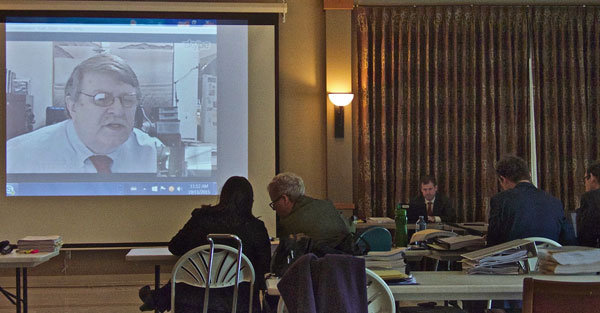
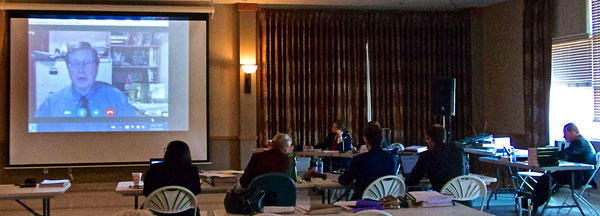
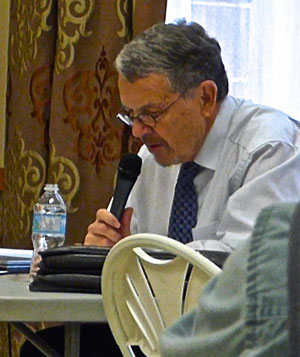
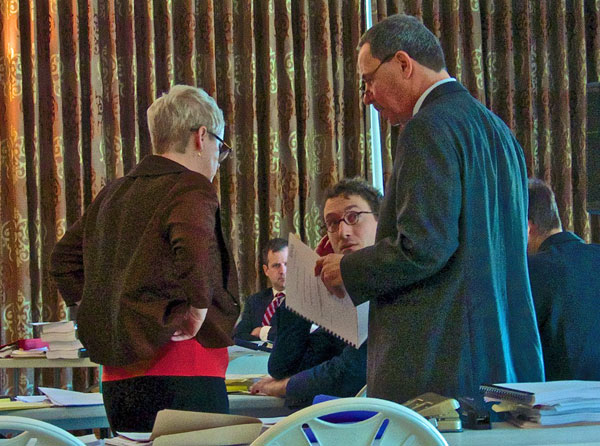
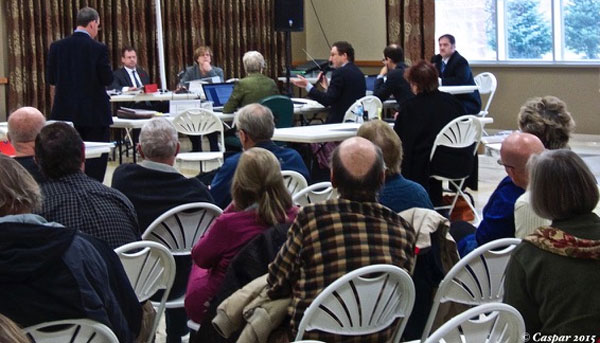
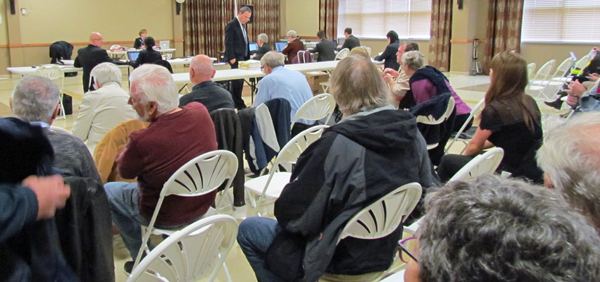




























http://www.nytimes.com/2015/12/16/science/san-diego-vows-to-move-entirely-to-renewable-energy-in-20-years.html?_r=1
The world is going to be so scary for you NIMBY’ers.
Or better yet…locate them in Toronto. No new transmission lines would be required. Oops, I forgot about the one in Toronto that is being decommissioned presently because it was producing 97% less electricity than predicted. That might be a snag.
You couldn’t pick a worse location than Prince Edwards south shore. It defies logic so it has to be about $$. Why not run them the length of the 401 highway? It is already covered in asphalt, is very open for wind and a lot closer for transmission.
Comparisons between Wolfe Island and the County are valid.
At IWT sites:
Biologists are observing habitat fragmentation and loss, wildlife disturbance, and life history disruption when turbines are placed in natural habitats.
Bird and bat abundance declines at wind turbine sites and this can become more pronounced with time – this is noted at Wolfe Island with Tree Swallows and Bobolinks.
Disruption of ecological links results in habitat abandonment by some species.
The loss of population vigour and overall density resulting from reduced survival or reduced breeding productivity is a particular concern for declining populations.
Collision mortality resulting from turbines and new transmission lines is increased during adverse weather conditions and migratory seasons. Especially vulnerable are raptors, passerines (songbirds), monarch butterflies, and bats. The consequential cost to agriculture from loss of pollination and natural insect control is a concern.
Placing turbines in close association with coastal wetlands can severely compromise movements and foraging of migratory waterfowl which is hugely significant in PEC.
The cumulative effects of multiple on and off shore wind developments have not been considered.
U.S. Fish and Wildlife Service now recommends the following: “Avoid placing turbines in documented locations of protected wildlife, known local bird migration pathways or near wetlands and staging areas and avoid known daily movement flyways between roosting and feeding areas, as well as bat breeding and nursery colonies or migration corridors.” The south shore of Prince Edward County, Amherst and Wolfe Islands meet these criteria and are completely unsuitable locations for IWTs.
And furthermore, the precautionary principle outlined in the Bergen Agreement, signed by Canada in 1990, states: “policies must be based on the precautionary principle. Environmental measures must anticipate, prevent and attack the causes of environmental degradation. Where there are threats of serious or irreversible damage, lack of full scientific certainty should not be used as a reason for postponing measures to prevent environmental degradation”.
In other words it is up to the government and IWT proponents to prove they cause no environmental or harm to human health – not the other way round as is the case in Ontario; a clear violation of the Bergen Agreement.
(From a report by Keith Stelling and Scott Petrie
http://docs.wind-watch.org/stelling-petrie-policy-guidance-document-final.pdf)
fyi new rules for turbine setbacks etc make them very unlike Wolfe island installations. not a valid comparison
It is maddening and unconscionable, that an individual with massive gaps in their knowledge of an area is allowed to approve ESA permits. This is another glaring example demonstrating why a judicial review of the whole process is long overdue.
Excellent, finally, an acknowledgement by a wind company that turbines can’t just be cited anywhere. Two down, twenty-seven to go.
washburn a large piece of that property was a wooded area go look at it now not much room left in that area for any wildlife
@wevil,
That property was formerly a mini golf and a driving range ?
A few gophers maybe ?
Lynda it is the property on East Lake where more than 300 cottages are being built they have been building there for at least 4 years
@wevil
“the cottage group was allowed to destroy the habitat of all the wildlife on that property”
Really?? That is shocking! Which property are we speaking about and who allowed them to destroy all that habitat? That is mind numbing! One certainly couldn’t make up a story like that.
Wevil; it is not that difficult for one to educate ones self on the environmental impact of Industrial Wind Turbines on the south shore. Few houses decimate bats and migrating birds or are built on top of the Blanding Turtles domain.
Chris Keen i see in your opinion only the wildlife in the wind turbine area is important you are not in the same league
@ “Wevil” – not even in the same league.
https://www.facebook.com/AmericanWindEnergyAssociation/videos/10152872502493775/
Chris Keen where were all the people when the cottage group was allowed to destroy the habitat of all the wildlife on that property and the wildlife displaced every time a new home is built in the country
The way things are going the County will be covered with wind turbines from coast to coast.
Studies show iwts, as they are being erected in Ontario, will not reduce C02.
The Ontario Society of Professional Engineers:
http://c.ymcdn.com/sites/www.ospe.on.ca/resource/resmgr/DOC_advocacy/2015_Presentation_Elec_Dilem.pdf
Seems politics has overrun the environment and human reason.
@”Wevil”: Perhaps if you attended the hearing instead of sniping from the sidelines, as usual, you’d have an appreciation for what was said. For example: wpd was required to describe every body of water on the proposed site. The individual who undertook this survey had no hydrological training and missed seasonal wetlands and water bodies – habitat for endangered species. Not only that, the scale of some of wpd’s maps was apparently incorrect. Despite this, the MNRF signed off on wpd’s application – i.e. this is a “process” to be finished ASAP whether the information is complete and correct or not . Another individual is objecting to the siting of a turbine that is too close to his property. Nobody’s “coming up” with this “Wevil” – it’s happened, it’s not right, and it needs to be rectified.
“…Murphy provided the ERT with a 2012 document from WPD indicating that it plans to put 80 more turbines on 4000 acres.”
amazing how there could be so many adverse affects of the windturbines.simply amazing what people will come up with if they don’t like something new simply amazing
Interesting. This is the second time in 2015 that Patrick Duffy has had his hat handed to him on such a Motion by a superior administrative tribunal.
Gillespie is doing exceptional work in the face of apparatchik resistance and LPO intermeddling with unlimited funding. If I were Gillespie, I would report Duffy’s conduct to the Law Society for discipline, for such an unprofessional and petulant outburst. “Bad faith”? This entire McGuinty/Wynne process emits the stench of bad faith…